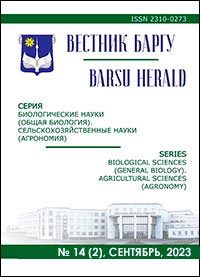BEETLES OF THE FAMILY HISTERIDAE (COLEOPTERA) IN THE ZOOLOGICALCOLLECTION OF THE LABORATORY OF TERRESTRIAL INVERTEBRATESOF THE STATE RESEARCH AND PRODUCTION ASSOCIATION “SCIENTIFIC ANDPRACTICAL CENTRE OF THE NATIONAL ACADEMY OF SCIENCES OF BELARUSFOR BIORESOURCES”
Keywords:
Coleoptera; Histeridae; Belarus; zoological collection; trophic specialization; biotopic confinementAbstract
Currently, 68 species of the beetles of the family Histeridae (Coleoptera) belonging to 21 genera have been
recorded on the territory of Belarus. The beetles of the family play a significant role in functioning of terrestrial
ecosystems. Having a wide ecological plasticity, histerid beetles can be often found in collected entomological material, however, they have a low representation in various collection funds because of difficulty of identification of
some species. This makes it difficult to conduct further faunistic and ecological studies of this taxonomic group of
invertebrates. The work contains information on the taxonomic composition and individual ecological features of the
beetles of the family Histeridae presented in the collection fund of the Laboratory of terrestrial invertebrates of the
Scientific and Practical Centre of the National Academy of Sciences of Belarus for Bioresources. Laboratory
processing of Histeridae collected from 1976 to the present has been carried out. Currently, the collection material of
the Laboratory of terrestrial invertebrates of the Scientific and Practical Center of the National Academy of Sciences
of Belarus for Bioresources includes 51 species (651 specimens) of histerid beetles, it constitutes 75 % of the species
of Histeridae of the fauna of Belarus. The presented species belong to 19 genera, among which the genus
Margarinotus prevails in the number of species (10). At present Gnathoncus rotundatus, Saprinus rugifer, Saprinus
virescens, etc. are not in the collection. Trophic specialization (zoophagous, zoosaprophagous, mixophagous) and
biotopic confinement (polysaprobionts, xylobionts, nidicoles, myrmecophiles) has been established for each species.
According to trophic specialization, zoophagous are represented by the largest number of species (24), first of all by
the species of the genera Dendrophilus, Hister, Gnathoncus, Saprinus, etc. At the same time, mixophagous are
represented by 17 species (Platysoma, Plegaderus), zoosaprophagous — 10 species. Among all ecological groups,
according to biotopic confinement, the largest number of the species is represented by the group of polysaprobionts —
32 species. These are such widespread genera as Atholus, Hister, Margarinotus, Saprinus, etc.
Ref.: 7 titles.
Downloads
Published
Issue
Section
License
Copyright (c) 2023 Вестник БарГУ Серия "Биологические науки. Сельскохозяйственные науки"
Это произведение доступно по лицензии Creative Commons «Attribution-NonCommercial» («Атрибуция — Некоммерческое использование») 4.0 Всемирная.
Авторы сохраняют за собой право заключать определенные договорные соглашения, касающиеся неисключительного распространения опубликованной версии работы (например, размещать ее в институциональном репозитории, публикация в книге) со ссылкой на ее первоначальную публикацию в этом журнале.





